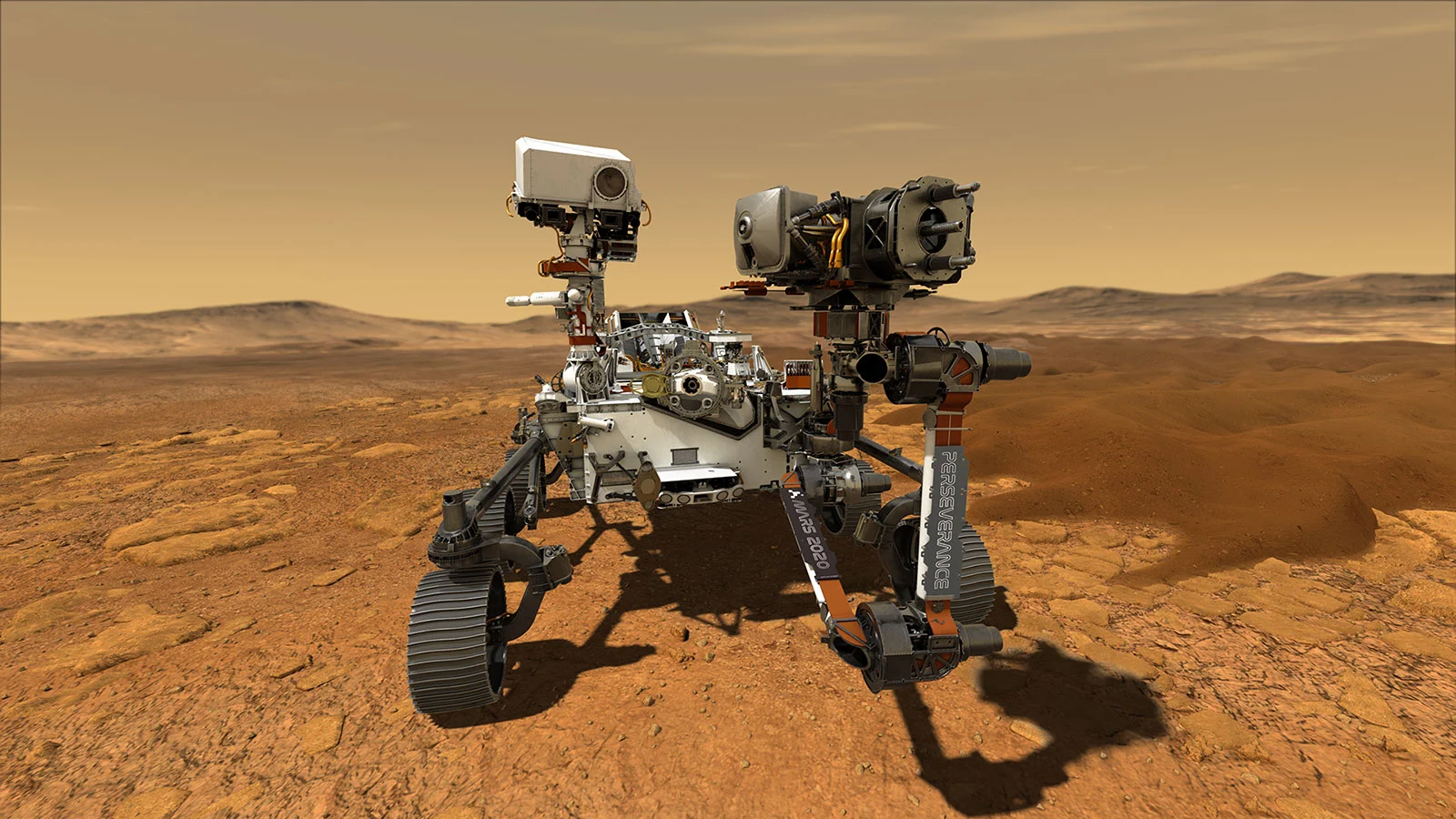
NASA's new Perseverance rover has landed safely on Mars!
Now past its 'seven minutes of terror' landing, this rover will soon begin exploring Mars.
All eyes are on Mars today, to witness the landing of NASA's Perseverance rover, which will search for signs that the Red Planet was once home to organic life.
On Thursday, February 18, 2021, at roughly 3:55 p.m. EST, the Perseverance rover safely arrived at its destination, touching down on the surface of Mars, in Jezero crater, after a nearly seven-month flight through space. The seven minutes prior to that, the final phase of its journey involved a daring dive through the Martian atmosphere to reach the surface.

The four main stages of Perseverance's landing are shown here, captured from NASA's 'seven minutes of terror' simulation of the rover's descent to the surface of Mars. Credit: NASA/JPL-Caltech/Scott Sutherland
"This landing is one of those pivotal moments for NASA, the United States, and space exploration globally — when we know we are on the cusp of discovery and sharpening our pencils, so to speak, to rewrite the textbooks," acting NASA Administrator Steve Jurczyk said in a statement. "The Mars 2020 Perseverance mission embodies our nation’s spirit of persevering even in the most challenging of situations, inspiring, and advancing science and exploration. The mission itself personifies the human ideal of persevering toward the future and will help us prepare for human exploration of the Red Planet."
SEVEN MINUTES OF TERROR
From its fiery entry into Mars' atmosphere to the high-g braking it endures as its parachute deploys to its powered descent to the ground, Perseverance performed each of these EDL maneuvers all on its own.
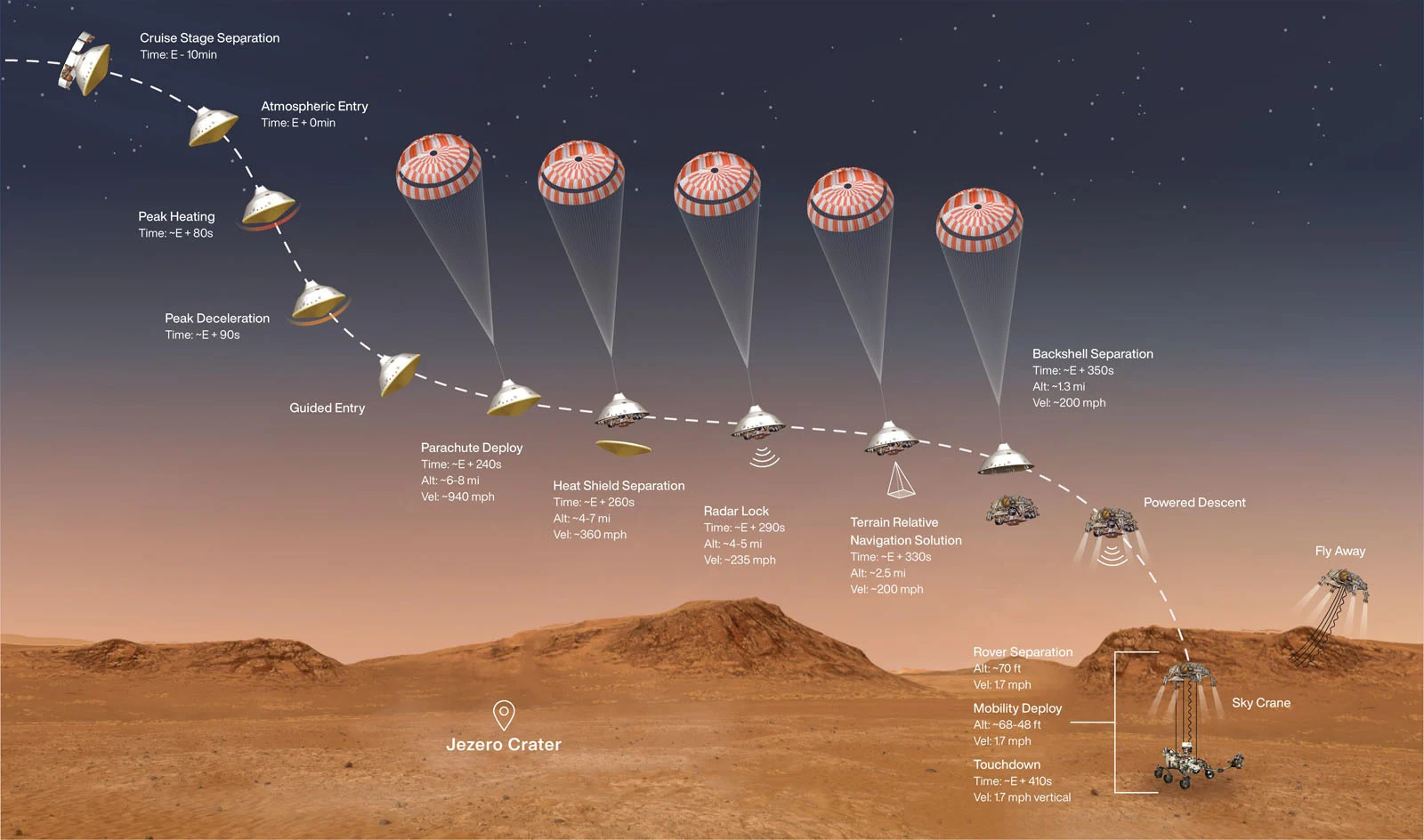
This infographic shows Perseverance's landing maneuver, from space to surface, noting the details of its speed and altitude at each step along the way. Credit: NASA/JPL-Caltech
With an 11-minute delay in communications between Earth and Mars at the time, there was no way for the landing to be controlled in real-time. The NASA engineers and scientists were sitting on the edge of their seats, both at home and in the EDL control room at the Jet Propulsion Laboratory in Pasadena, listening in as the rover signaled its progress through these automated stages. They can now relax, though, as Perseverance performed this landing perfectly, and is now safely on the surface.
This is not the first time NASA and JPL attempted a landing like this. On August 6, 2012, the Curiosity rover — Perseverance's predecessor and near-twin — flawlessly performed a similar landing in Gale Crater. Working from that success, Thursday's landing went just as well. The big difference between then and now, though, is that Perseverance added a new and innovative extra step.
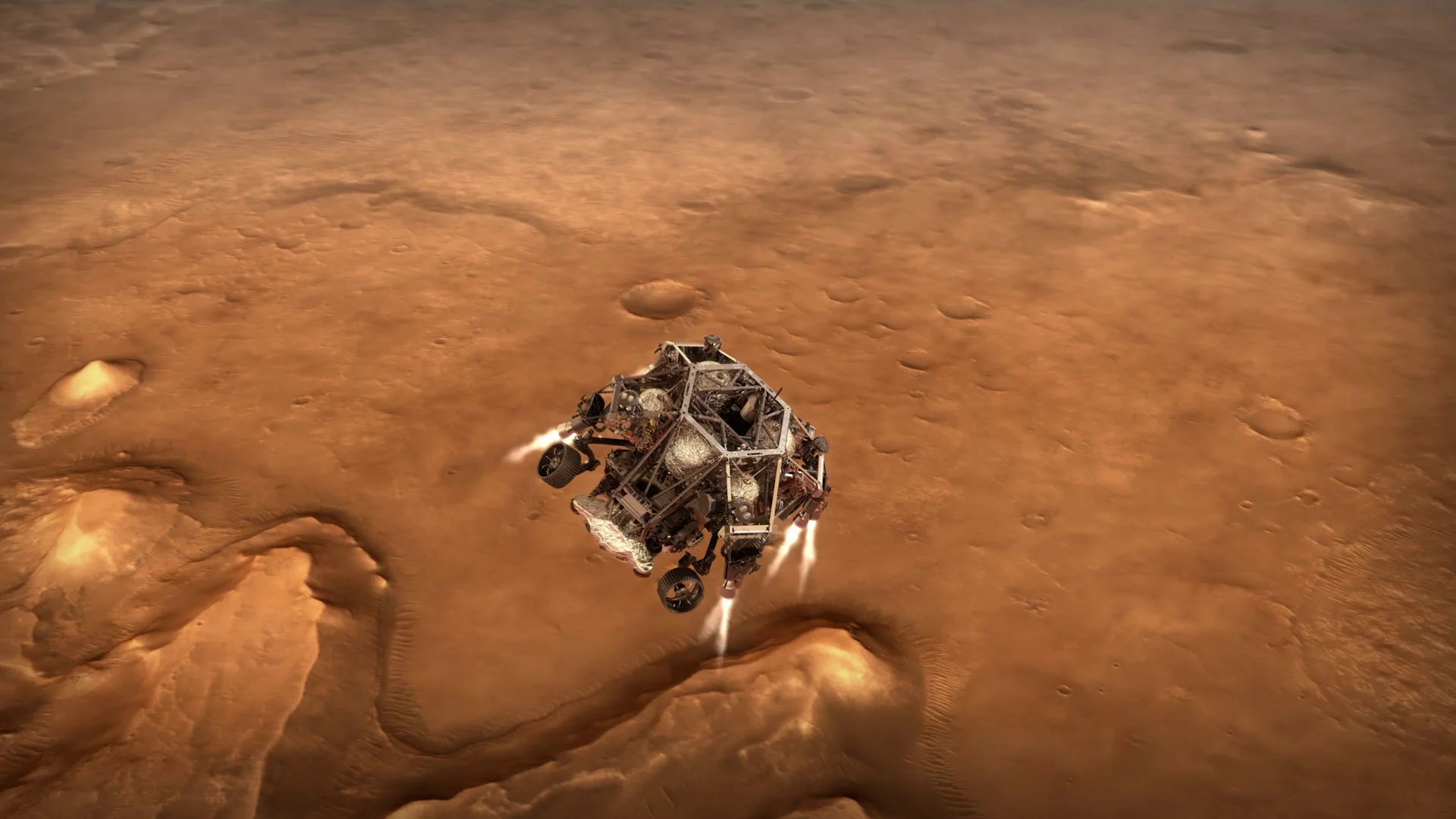
Perseverance's descent stage will fly the rover, like a jetpack, to a safe area to land. Credit: NASA/JPL-Caltech
Once the descent stage separated from the backshell, and the rover's powered descent had begun, Perseverance didn't head straight towards the surface, as Curiosity did. Instead, the descent stage flew across the terrain, while on-board computers analyzed images of the surface below to determine the safest landing point. Only when it found a suitable location did it approach the ground and perform the 'skycrane' maneuver, lowering Perseverance gently to the floor of Jezero crater.
WHAT IS PERSEVERANCE?
In NASA's continued exploration of the planet Mars, they are now building upon the work of previous missions, especially the Curiosity rover, to take things to the next level.
Perseverance, formerly named Mars 2020, is NASA's next nuclear-powered Mars rover.
The Spirit and Opportunity rovers determined that Mars' environment was favourable for liquid water to exist on the surface. The Mars Phoenix mission supported these efforts, and together they confirmed that Mars was a warmer and wetter planet in its distant past. Touching down in Mars' Gale Crater, Curiosity discovered signs that those warmer, wetter conditions could actually support life as we know it.
Perseverance, which is based on the same design as Curiosity, has the tools needed to go beyond that. With a brand new suite of science instruments, this mission will actually look for signs that living organisms did, indeed, inhabit those environments long ago.
Watch below: Perseverance - The search for ancient life on Mars
If Perseverance is successful in this mission, it will likely be the most profound moment in human history — the discovery that life existed on a planet beyond Earth!
There's an added bonus for this mission, something which has never been done before. NASA has sent Ingenuity, a tiny helicopter, along with Perseverance. While there are no plans for Ingenuity to participate in the rover's science mission, it will demonstrate for the very first time whether powered flight is possible on Mars!
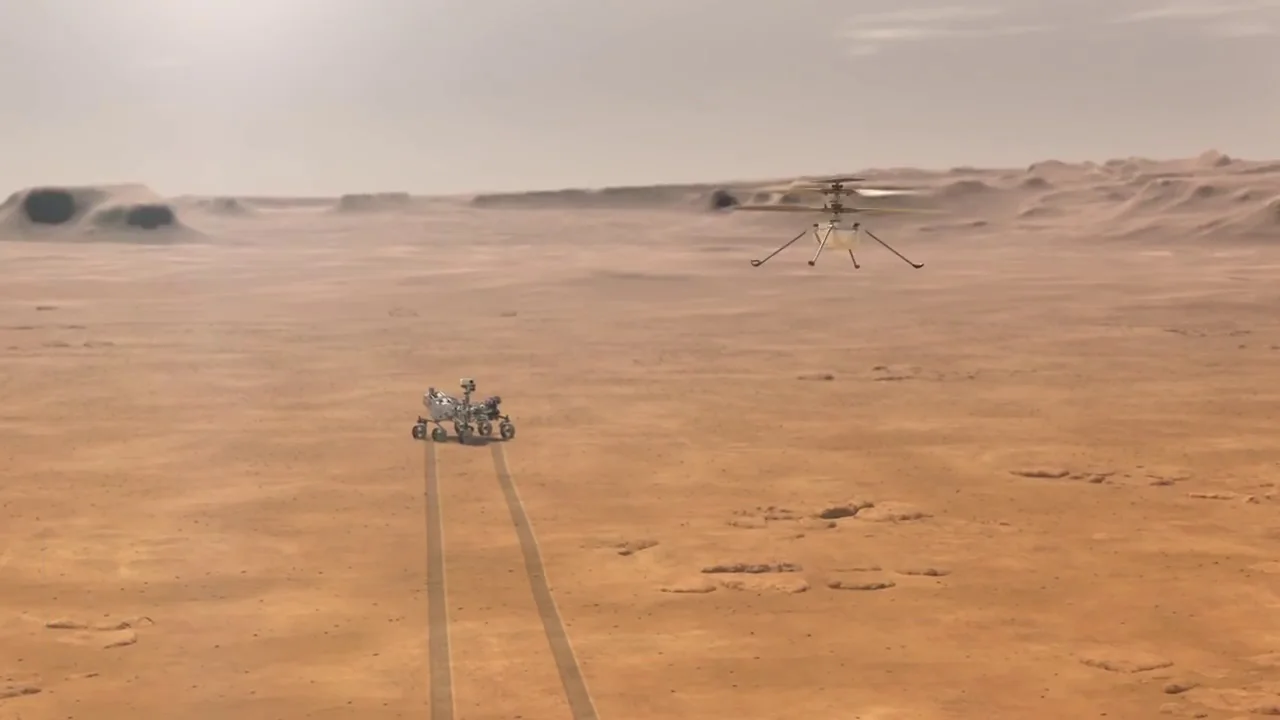
This artist conception drawing shows Mars Perseverance, with the Mars helicopter Ingenuity flying above Jezero crater. Credit: NASA/JPL-Caltech
Additionally, the Perseverance rover will be the very first to gather materials for future 'sample return' missions. Basically, the rover will drill samples from the rocks in Jezero crater and lock them away in canisters. These canisters will then be a target for some future mission, which will retrieve and launch them to Earth. Here, scientists can subject those samples to a range of tests far greater than could be done by any robotic mission we send and far faster as well.
WHERE IS PERSEVERANCE GOING AND WHY?
After an exhaustive search and decision-making process, NASA pinned down Perseverance's landing site to Jezero, a 45-km-wide impact crater in Mars' northern hemisphere. Named after a town in Bosnia-Herzegovina, the word translates to 'lake'.

Overlaid on this false-colour Mars topography map are the locations of the various NASA Mars missions and their dates of operation on the surface, including the upcoming Perseverance rover. Credit: NASA/JPL-Caltech/Scott Sutherland
The name 'Jezero' is very appropriate. According to NASA, the crater was once home to a lake, fed by a wide river delta along its western rim, which "could have collected and preserved ancient organic molecules and other potential signs of microbial life from the water and sediments that flowed into the crater billions of years ago."
"The landing site in Jezero Crater offers geologically rich terrain, with landforms reaching as far back as 3.6 billion years old, that could potentially answer important questions in planetary evolution and astrobiology," Thomas Zurbuchen, associate administrator for NASA's Science Mission Directorate, said in a NASA press release back in November 2018. "Getting samples from this unique area will revolutionize how we think about Mars and its ability to harbour life."

Jezero Crater on Mars has very similar mineralogy and geology to Turkey's Lake Salda, here on Earth. Credit: NASA Earth Observatory
According to NASA's Earth Observatory: It just so happens that Lake Salda is the only known lake on Earth that contains the carbonates and depositional features (deltas) similar to those found at Jezero Crater. The first image above shows Jezero Crater as observed by MRO's Context Camera. Spectral data showed signatures of carbonates on the western edge of the crater, which scientists believe to be the shoreline and beaches of an ancient lake. The carbonates are also present in the delta, which is the planned site of the Perseverance landing. The second image shows Lake Salda on June 8, 2020, as observed by the Operational Land Imager (OLI) on Landsat 8. The lake contains alluvial fans full of rock deposits eroded and washed down from the surrounding bedrock (similar to the delta in Jezero). By studying how material is deposited in Lake Salda, the team can learn more about the various depositional processes at Lake Jezero. The white shoreline around Lake Salda is comprised of sands and gravels that are dominated by hydromagnesite, which is similar to the carbonate minerals detected at Jezero. Horgan explained that the hydomagnesite sediments along Lake Salda's shoreline are thought to have eroded from large mounds called 'microbialites' — rocks formed with the help of microbes. In Lake Salda, they formed from microbial mats that lived just beneath the surface of the water near the shoreline. As the microbialities grew, they incorporated carbonate materials and created large terrace islands.
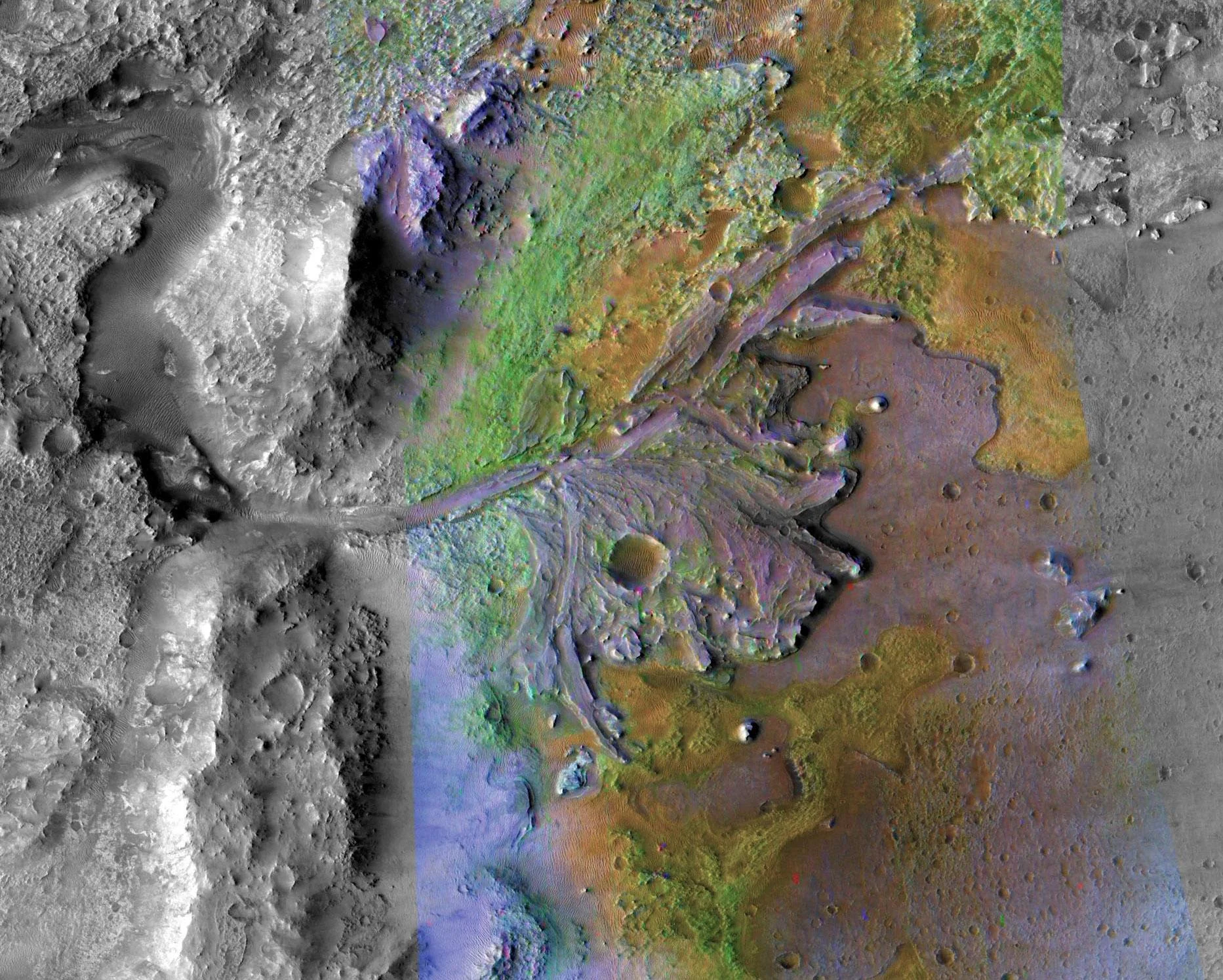
This image shows a false-colour view of the river delta along the western rim of Jezero Crater. The colourful formations on the right side of the image are from a spectral analysis from orbit, revealing the presence of sediments that have been chemically altered by water, such as clays and carbonates. Credit: NASA/JPL/JHUAPL/MSSS/Brown University
Jezero crater was one of over 60 sites considered by the Perseverance team. From the types of formations and sediments detected from orbit, it was known to have been filled with lake water on two different occasions, with a dry period in between. There was also another advantage, in that another of the sites — Northeast Syrtis — was just 50 kilometres away. That's relatively close, even with the rover's slow top speed of 152 meters per hour. The team even tried for a compromise, as they considered a spot midway between the two (appropriately named 'Midway').
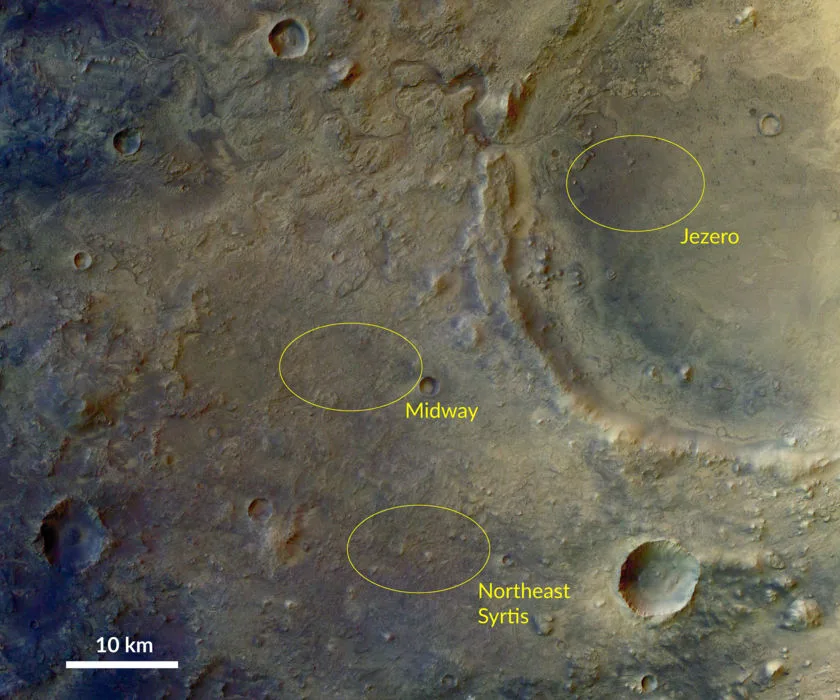
The location of the final three landing sites under consideration for Perseverance, along with the projected landing ellipses. Credit: ESA/DLR/FU Berlin/Emily Lakdawalla
Jezero has everything going for it for Perseverance's mission. Not only does it have an abundance of clays and water-affected minerals in its river delta, but there are signs of impact craters in the delta as well. When those impacts occurred is unknown, but given that meteorites are potential sources of organic molecules, impacts could play a part in the development of life. So, this is a very attractive location, indeed, with great potential for extended missions to explore the regions beyond.






